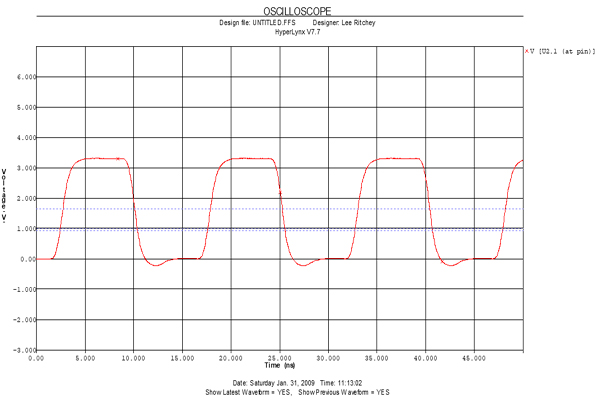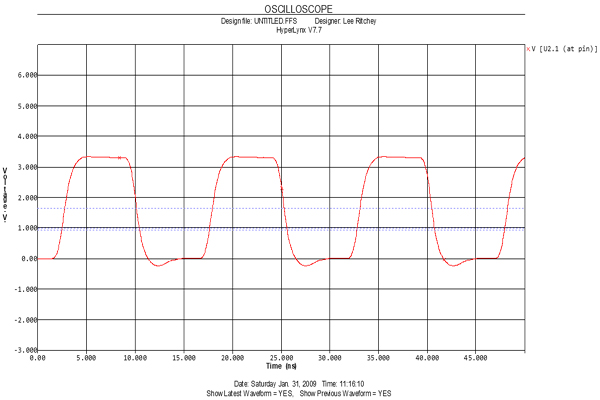There are as many as seven different impedances called out in various design specifications. Among these are:
- 33 Ohms for Rambus memory
- 50 Ohms for most high-speed logic
- 65 Ohms for the PCI bus
- 72 to 75 Ohms for analog circuits
- 85 Ohm differential for PCIExpress (42.5 Ohms single-ended)
- 95 Ohm differential for USB (47.5 Ohms single-ended)
- 100 Ohm differential impedance for most high-speed Internet links (50 Ohms single-ended)
Successfully designing a PCB with more than one of these impedances can be a difficult, if not impossible challenge. The main challenge is designing a PCB stackup that has enough routing room for all the traces of each impedance while maintaining a manufacturable and economical product. It would be of great value if there were a way to create a design that was all one impedance. If so, which impedance would be best?
Where Did These Impedances Come From?
It’s helpful to have a sense of where the foregoing impedances came from. As seen below, their origins are diverse. Some of their uses are no longer applicable, rendering certain impedances obsolete. Below is the history of these diverse impedances.
Rambus:The company Rambus began making a memory system that was expected to deliver very high transfer rates. The architecture was such that it was anticipated that the address and data buses needed to be 33 Ohms to function properly. The jury is still out on this , as this memory technology did not catch on, so we do not need to worry about designing this kind of transmission line into our stackup.
50 Ohms: 50 Ohms has been the impedance of choice for high-speed computing since the outset of ECL and GaAs logic. It is a useful impedance, as it matches the impedance of virtually all test equipment, making accurate measurements easy.
65 Ohms: This impedance was first specified for the transmission lines on four-layer PCB motherboards and most game consoles. The impedance was arrived at somewhat accidentally by measuring the impedance of a trace on a typical four-layer PC motherboard when it was determined that impedance control would be needed as speeds continued to increase. See Reference 1 for a more detailed treatment of this subject.
72 to 75 Ohms: Originally, TV antennas were mounted on rooftops and connected to TVs using 300 Ohm twin lead transmission lines. This twin lead transmission line was not shielded, so it was susceptible to noise from the surrounding environment. A shielded coaxial cable was needed to solve this problem. Since building a 300 Ohm coaxial cable was impractical, a 2:1 stepdown transformer was used to “transform” the impedance down to 75 Ohms. Since then, this impedance cable has been used for systems that have analog signals.
85 Ohms: The 85 Ohm differential impedance was arrived at by engineers at Intel who determined that the bit error rate would be lower with an 85 Ohm differential impedance than with a 100 Ohm differential impedance. This has proven to not be true. Later in this article, it will be shown that differential impedances are not necessary in PCBs.
95 Ohms: This differential impedance was derived by measuring a number of USB cables and discovering that their differential impedance centered around 95 Ohms.
100 Ohms: The early Internet was connected by twisted pairs obtained from phone suppliers. Originally, the twisted pairs already in buildings to connect phones were used to connect PCs and other terminal devices to routers, switches, and hubs. Because the differential impedance of these twisted pairs happened to be about 100 Ohms, this impedance became widely used in the industry.
Observations About Differential Pairs Routed on a PCB
When members of a differential pair are routed over a plane on a PCB, the primary partner is the plane over which each signal is routed. From Reference 2, it can be seen that each side of a differential pair is, in fact, a single-ended signal parallel terminated in the single-ended line impedance. The notion that tight coupling is beneficial originated from this architecture. The reality is just the opposite.
Tight coupling carries with it a number of negative side effects. Among these drawbacks is the fact that when one trace is routed very close to another, each drives the impedance of the other down, requiring that the traces be narrowed to get back to the original target impedance and driving up copper loss. Another negative effect involves the inability to separate the traces to route through a pin field, such as a 1 mm pitch BGA, without suffering very large impedance changes.
Should product developers remain unconvinced that there is no need to route differential pairs with a differential impedance and tight coupling on a PCB, all they have to do is tour any conference, such as DesignCon, and look at the demonstration setups in many of the booths. The differential pairs will each be connected with a separate 50 Ohm coaxial cable, often very far apart. Attempting to demonstrate some benefit to tight coupling has no real value. Designs we do every day with data rates as high as 32 Gb/s are done according to the “not closer than” rule in order to avoid unwanted interaction between the two members of a differential pair.
From the above discussion, it should be clear that each member of a differential pair, when routed on a PCB, is a single-ended signal parallel terminated in the line impedance, and there is no benefit to tightly routing them to each other.
Selecting an Impedance
If it is possible to route all the signals on a PCB to only one impedance, what would be the best impedance to choose? As discussed above, all signals routed on a PCB are, in fact, single-ended, even if their use is for differential signaling. Since all of the test equipment we have available with which to make measurements is designed with input and output impedances of 50 Ohms and their connecting cables are 50 Ohms, it turns out to be a good target impedance.

Figure 1. PCI Driver Simulation Driving a 50 Ohm Transmission Line
Figure 1 depicts the simulation of a typical PCI driver connected to a 50 Ohm transmission line.
 Figure 2. PCI Driver Simulation Driving a 65 Ohm Transmission Line
Figure 2. PCI Driver Simulation Driving a 65 Ohm Transmission Line
Figure 2 is a simulation of the same typical PCI driver connected to a 65 Ohm transmission line.
As can be seen in Figure 2, there is little difference in the signal, so designing PCI buses with 50 Ohm transmission lines is acceptable.
The primary application of 72 to 75 Ohm transmission lines is driving or receiving signals from an outside signal source such as a TV or some antenna. These signals are nearly always terminated on a device at the edge of the PCB. The length of the connection is short. If this connection is done with a 50 Ohm trace, there will be an impedance discontinuity. Rarely will this short discontinuity result in a significant degradation of the signal. If there is concern that this discontinuity will be a problem, simulation of the signal path with the two different impedances can be performed. It is rare that this brief discontinuity will this turn out to be a problem. As a result, 72 to 75 Ohm traces are not necessary.
The 85 Ohm differential impedance is really two 42.5 Ohm single-ended transmission lines. As noted earlier, this odd impedance is of no benefit, so routing these nets as two 50 Ohm lines is acceptable and, in essence, preferred.
The 95 Ohm differential impedance, which is two 47.5-Ohm single-ended lines in the USB standard has a tolerance of +/-15%. Using this tolerance, the single-ended impedance can range from 40.375 to 54.625 Ohms, so a 50 Ohm transmission line will satisfy the standard.
Earlier, it was pointed out that a 100 Ohm differential impedance is achieved by using two 50 Ohm single-ended transmission lines. Designing a PCB stackup using only 50 Ohm transmission lines greatly simplifies the process while also ensuring that the impedance is verified as correct at the end of the PCB production line.
Conclusion
All the high-speed protocols listed in this article, except Rambus, can be successfully implemented using 50 Ohm transmission lines. This simplifies designing PCB stackups and makes impedance and other measurements easier.
REFERENCES
1. Ritchey, Lee, "Why is the PCI bus Impedance Specification 65-ohms?" Speeding Edge, January 2009.
2. Ritchey, Lee, "Does Differential Signaling Require 100-ohm Differential Impedance?" Speeding Edge, December 2021.
3. Ritchey, Lee, "Tight or Loose Coupling Best for Differential Signaling?" Speeding Edge, Printed Circuit Design & Fab, March 2020.

